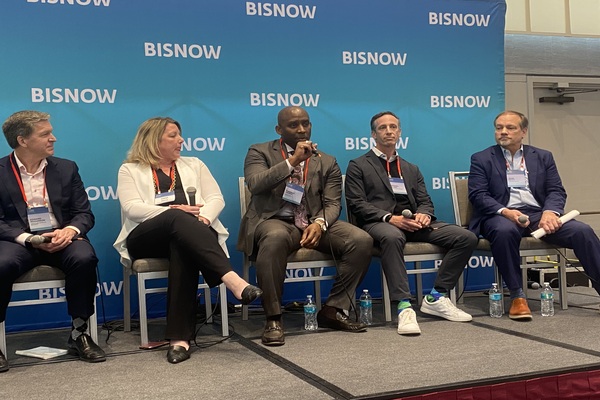The pandemic was an epochal inflection point, working its pernicious tentacles around the collective global throat and squeezing it for two-plus years. It’s finally relented, but its impact is indelible—and that includes on the hospitality industry: the way it operates, the way it functions, the way customers engage with it.
The change may be immutable, but according to some hospitality folk, speaking at the Bisnow Lodging Investment Summit, there is—finally—some reversion to dependability.
“Things are returning back to the way they were,” said Michael Blank, a principal at hotel owner and asset manager Woodmont Lodging. “There are changes in technology, but we are seeing a creep back to the status quo. What sticks and what doesn’t.”
Though the pandemic and its attendant consequences were far different from black-swan events of the past, hoteliers were far more prepared, thoughtful and intelligent about handling the situation. Revenue management is a stratagem, a mano a mano duel: how much is a customer willing to pay to stay at a hotel? And, as a hotel, how far up to edge can I go to not turn the customer off and onto a competitor hotel?
SMARTER COURSE
Revenue per available room, or RevPAR, is the default go-to, sign-of-health metric in the hospitality industry, an amalgamation of occupancy and rate. Consider 9/11, when the hotel industry deeply discounted rates in an effort to incite demand. It was not the smartest of maneuvers and it took the industry years to get back to pricing health. This time around, many hotels were literally closed, so no rate was going to attract business. In hindsight, good.
“It was the first time we learned our lesson and preserved rate,” said Sara Gulla, SVP of asset at Pebblebrook Hotel Trust, a real estate investment trust that owns hotel.
And it’s carrying over now as the pandemic has subsided. “Business is back and we are driving rates stronger than ever,” said Edward Hoganson, EVP, CFO and CIO of Crestline Hotels & Resorts, which manages hotels.
Hotels are not only getting their revenue game right, they are making sure the cash drives down to the bottom line. Revenue is only good if you can hold onto it, and over the years, it’s been harder to turn a profit with the gauntlet of rising expenses, from labor to utility costs.
On the labor front, it’s been harder to fill open positions, and when they are filled, it’s more expensive, which puts the onus on owners and operators to find other ways of cost containment. “We changed things structurally and operationally,” said Gulla, such as consolidating positions and clustering to keep staffing at an optimal level.
“Technology allows us to streamline operations and allows us to run leaner with less staff,” said Hoganson.
The pandemic also altered the business mix. Traditionally, hotels banked on big business, especially group and corporate, on Sundays to Thursdays. That’s not the case anymore, according to Thomas Penny, president of management company Donohoe Hospitality. Leisure guests typically filled the weekends, but the impact of remote working and “bleisure” has caused a shift. “We used to discount on weekends, but leisure is now paying corporate-like rates,” Penny said, where a blended trip might have a few days on the front or back end.

THE NEW WORKFORCE
As the labor workforce has changed, so, too, has the worker mindset, according to Penny. Penny’s first job in hospitality was working in fast food at Roy Rogers when he was 13 years old (he altered his birth certificate to make it appear he was 16). Penny joined Donohoe in 1996, working various operational jobs. His job now is to recognize and foster talent, but kids today, he said, aren’t as patient as they used to be.
“We have young people coming in who want to move up quick,” he said. “It took me 19 years, serving tables and making beds. We have to do a better job at introducing opportunity. This is a low-floor, high-ceiling business.”
“We need to do a better job of marketing the industry—it’s a fun business,” Gulla said.
It’s also a tiring one and not a profession that is done remote, like a lot of workers today, who can work from their kitchen table through a computer. Hospitality—until, perhaps, AI takes it all over—is a face-to-face business.
Still, employers must be more understanding of their employees’ lives outside the workplace. For instance, “We have to be more conscientious of commutes,” said Blank, “and what it takes to grow. People just don’t show up for interviews sometimes. We have to search our own souls to attract and retain staff.”
“We have a responsibility to give opportunity and show the way,” said Hoganson. “Wages are up and for a good reason.”
Added John Fetty, associate principal at Lessard Design, “People want to work where they are comfortable.”
Still, barriers exist, especially in the corporate ranks. Though the front of the house is decidedly diverse, above the house is historically not. “DEI is the backbone of our industry,” Gulla said. “We have to believe in the benefit of different ideas and perspectives and that comes with diverse hiring.”
Hoganson noted that 75% of its hourly employees are “people of color or woman,” while less than 25% are c-level.
Penny, who is Black, said there is enough room in the industry for everyone and, in a rather poetical moment said: “We need the boardroom to look like the breakroom.”
